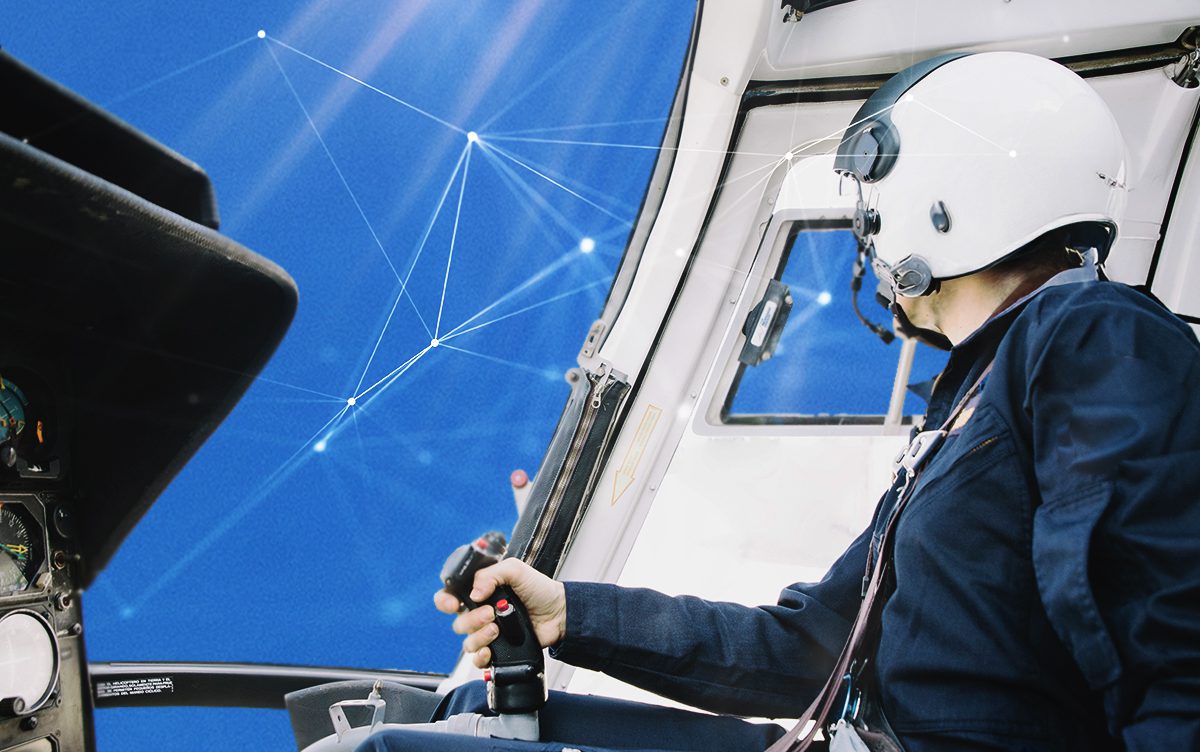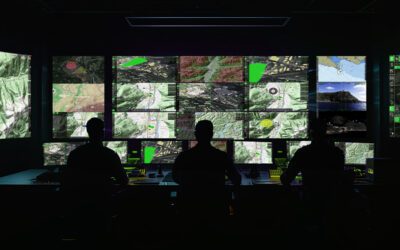The high-tech world of aviation, and in particular helicopter avionics, is a natural arena for artificial intelligence. Indeed, human and AI collaboration is already making the helicopter cockpit a far more advanced and integrated environment, where the ability to ‘data crunch’ that makes AI so valuable is providing human operators with more efficient mission capabilities. The concept of humans and AI working together is still treated with some trepidation by the general public, who are unaware of the advancements in AI’s ability to develop at an almost exponential rate.
In this article, we’ll examine how human-AI collaboration is becoming the norm rather than the exception, and how AI-driven decision-support systems are working alongside humans to transform aviation operations. We’ll look at why this collaboration is so important and why the concept of AI and humans working together is directly interlinked to the progression of avionics, particularly in helicopters and vertical flight. We’ll also introduce the groundbreaking FlySight OPENSIGHT system, which already employs advanced AI to assist both airborne and ground-based crews, and examine the future of AI and human collaboration.
The importance of collaboration between humans and AI in aviation
In situations where the most accurate, fastest and most complete data set can be mission-critical, AI is proving to be a highly effective tool for human operators. Assistive AI utilises complex algorithms and embedded programming to perform intrinsically basic tasks, thereby freeing up the human operator to make informed decisions.
AI in avionics, and particularly in helicopter platforms, like any other technology in avionics, is there to assist the human operator. What AI does better than most humans is process large amounts of information very quickly. With the benefit of machine learning in place, AI can also adapt and respond to changing parameters. In the same way that humans instinctively look for patterns within data sets, AI can do the same, and then introduce those skills and the resulting data analysis into a real-time situation. This can make all the difference when, for example, conducting a surveillance operation, targeting a vehicle within an urban setting, or creating an effective search pattern in a SAR situation.
How AI-driven decision-support systems can assist operators
Human AI collaboration is both practical and advantageous in pre-, during, and post-mission scenarios. Using a variety of AI systems, humans can gain a deeper understanding of essential information, such as terrain, urban layout, or target identification pre-mission, and how all these elements come together.
During the mission, AI and human collaboration works in tandem to analyse real-time data, collect, collate, and communicate that information to ground-based control teams, as well as enhance the situational awareness of the airborne units, even in poor or deteriorating weather conditions.
Post-mission, the information collected can be ‘crunched’ by AI far more quickly than by human analysis, including sifting the relevant information from the background ‘noise’ for a clearer, more precise overall assessment.
How does AI achieve all this? Simply through the use of designated routines, precise coding and algorithmic structures. Let’s take a quick look at some of the most essential systems currently in use.
Flight Management Systems (FMS)
The vast majority of AI and human collaboration in rotor aircraft falls under the auspices of flight management systems. These cover a wide range of operational procedures, from flight planning through to mission-critical systems such as target acquisition and spatial awareness. Collectively, they enable ground crews, maintenance teams, pilots, operators, data processors, and command personnel to develop a cohesive method of operation that maximises every second in the air.
Rotorcraft are exceptionally expensive to run and maintain, so any flight management system that ensures the most resource-efficient method of operation must be employed at every level. From the cockpit to the ground, FMS is the perfect location for AI-human collaborations.
AI-assisted route optimisation
While flight routes are an integral part of any operation, AI can help in determining the most efficient route to take while in the air. This can be adjusted in real-time, too, especially if conditions change or the mission parameters are altered. With AI-assisted route optimisation, the AI component of the FMS adjusts routes based on weather, traffic, and fuel efficiency, improving operational performance. However, the final decision will always be the human pilot’s, regardless of the information received.
AI-assisted target recognition
AI-assisted target recognition is a huge benefit in surveillance operations, especially when a target is ‘masked’ by background noise. For example, suppose a surveillance operation involves pinpointing, acquiring, and following a target vehicle on the ground in an urban area where a great deal of extraneous data is being collected. In that case, AI can filter out the unnecessary data and focus on the target vehicle.
AI-assisted spatial awareness
AI-assisted spatial awareness has been one of the most significant safety benefits for helicopter pilots and operators to develop in recent years. Using a combination of computerised Enhanced Reality, sensor fusion and machine learning, AI can assist in the detection, interpretation and reaction to the environment. This is particularly useful in situations where the visual element is limited, such as in haze or smoky conditions, or when a cataclysmic event, such as a landslide, fire, or earthquake, has drastically altered the topography, or in a hostile combat zone. AI can track nearby aircraft, power lines, terrain, drones and even large flocks of birds that could pose a threat to the safety of the aircraft and its crew.
Decision support systems
AI-assisted decision support systems are not intended to replace pilots or operators. They instead provide real-time recommendations to pilots, who can then act on the information provided. DSS can also enable ground controllers to make strategic decisions based on the latest information and relay new directions to mobile units in seconds.
Maintenance diagnostics
AI-human collaborations are also practical on the ground. AI can analyse engine and component data to forecast failures before they happen, as well as ensure maintenance programs are carried out on time, reducing downtime and improving safety. As with any safety element, AI-driven maintenance diagnostics are just a starting point. A human engineering crew should always conduct the final review and complete the maintenance work orders.
Autonomous control of the airport
In the same way that an Autopilot works, AI can take over the operation of an aircraft, allowing the operator to carry out other tasks. Again, due to the safety aspect of this particular task, any autonomous control handed over to AI would still be controlled by a skilled and human pilot, who would be able to take back control of the joystick immediately if necessary.
FlySight OPENSIGHT – Human and AI collaboration in action
You don’t have to wait to see how AI and humans working together can be applied to avionics – it’s already happening. FlySight’s OPENSIGHT platform combines a comprehensive suite of mission console AI, ideally suited for applications ranging from Search & Rescue to surveillance, intelligence gathering, and both military and civilian use. OPENSIGHT Mission Console is a turnkey solution that uses existing hardware to introduce Enhanced Reality and AI-assisted programming.
From overlaid augmented mapping to providing a clearer view of the terrain in hazy or smoky conditions, target acquisition and identification, to real-time command and decision-making features, OPENSIGHT demonstrates how AI can integrate into any cockpit and any scenario. OPENSIGHT has a significant impact on ASO workload reduction and improves situational awareness in both general aviation and ISR platforms. It is, quite simply, the future today, delivering a user-friendly system that augments the experience of the crew, command team, maintenance crews and platform operators, improving mission efficiency at every level.
The future of AI and human collaboration for aviation is already in motion, but the beauty of these systems is that they are constantly evolving and adapting to the demands of aerial use. Future applications could include the integration of generative AI in flight operations, cognitive computing, and adaptive avionics, as well as utilising AI for pilot training and mission simulation.
The benefits of using AI-driven decision support systems and other AI technologies to support humans during helicopter missions are numerous, including reducing user fatigue, improving efficiency, and ensuring the safety of both the aircraft and its crew, even in adverse weather or challenging conditions.
Find out more about OPENSIGHT
You can find out more about FlySight’s OPENSIGHT platform by browsing our OPENSIGHT page. Here, you’ll find interesting and informative videos, blogs, and detailed information on the platform and its various modular solutions. Or you can get in touch to find out more about the advanced AI decision-support features of the OPENSIGHT Mission Console solution.




